The Vatican Museums are not only one of the best known and most visited museum complexes in the world, but they are a treasure chest where some of the greatest masterpieces in the history of art are carefully kept. The list of must-see works that can be admired in this authentic symbol of beauty recognized in every corner of the globe is really very long, and to understand their importance it is enough to say that among the thousands of wonders preserved inside the Vatican Museums “there is also” the Sistine Chapel. The collection of the Vatican Museums, on the other hand, is really huge and very rich given that it consists of what has been collected by the popes over the centuries. The Vatican Museums themselves are a gigantic and wonderful work of art that runs all within Vatican City occupying much of the large Belvedere courtyard and can itself boast a very long and rich history. The foundation of the Vatican Museums is traced back to 1506, when Pope Julius II set up the sculpture collection (including theApollo of the Belvedere and the Laocoon) in the Cortile delle Statue (later transformed into today’s Cortile Ottagono), while they have been open to the public since 1771. Today nearly 7 million tourists visit them each year and are enchanted by the works of the various Michelangelo, Giotto, Leonardo, Raphael, Caravaggio and many, many others. The Vatican Museums have a plural name because they are actually a complex of different museums. Here are the 10 must-see stops during a visit, perhaps spread over several days since the Museums are so large.
A summa of the best of Italian painting: from Giotto to Beato Angelico, from Melozzo da Forlì to Perugino and Raphael, from Leonardo to Titian, Veronese, Caravaggio and Crespi. These are just a few of the masters of art history whose works are preserved in the extraordinary Vatican Pinacoteca, which is located in a building built in the 1930s by Pope Pius Xii n a part of the 19th-century Square Garden, isolated and completely surrounded by avenues. A place chosen not at random to ensure the best lighting conditions in relation both to the proper conservation of the works and to their optimal aesthetic enhancement. On the other hand, the origins of the Vatican Picture Gallery are much older since they date back to the 18th century with a collection that has continued to grow year by year until reaching the current nucleus of about 460 paintings, arranged in the eighteen rooms according to criteria of chronology and school, from the so-called Primitives (12th-13th centuries) to the 19th century.
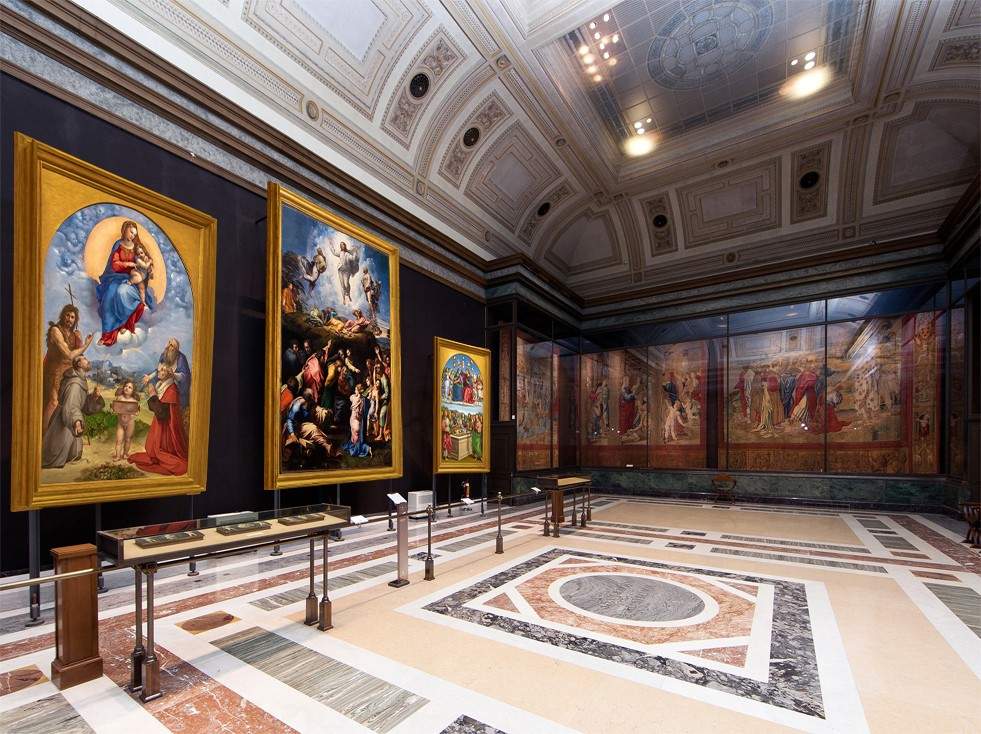
Raphael’s four rooms (Stanza della Segnatura, Stanza di Eliodoro, Stanza dell’Incendio di Borgo, Sala di Costantino) were formerly part of an apartment on the second floor of the apostolic palace chosen as his own residence by Pope Julius II della Rovere. Bordering the papal apartment, on the other hand, is the complex of Raphael’s Loggias, which includes three rooms on as many floors of the Apostolic Palace that were frescoed to Raphael’s design by his workshop. The most famous is certainly the one on the second floor where there is a cycle of frescoes with decorations and biblical stories and grotesques dating between 1517 and 1519. Here all the pillars and walls have stucco and fresco decoration with figures mainly related to mythological themes, while others reproduce famous works of art, such as the Belvedere Torso, Donatello ’s Saint George and Lorenzetto’s Jonah in the Chigi Chapel, perhaps sculpted to a design by Raphael himself; still others are related to contemporary events of the pope and his court. Under the vaults, however, are four stories surrounded by stucco frames of various shapes.

When one speaks of the Sistine Chapel, the first image that comes to mind is surely that of Michelangelo’s Last Judgment, but in this, which is one of the most mystical places in all of Christendom, every corner is an authentic masterpiece. The Sistine Chapel, the place where the conclave for the election of the new pontiff takes place, is named after Pope Sixtus IV della Rovere who had the ancient Cappella Magna renovated between 1477 and 1480. The 15th-century decoration of the walls was done by such masters as Pietro Perugino, Sandro Botticelli, Domenico Ghirlandaio, and Cosimo Rosselli. On the vault, on the other hand, Pier Matteo d’Amelia painted a starry sky, while Michelangelo Buonarroti began work on the Sistine Chapel in 1508 at the behest of Pope Julius II della Rovere. For four consecutive years Buonarroti painted the vault and, on the upper part of the walls, the lunettes. Toward the end of 1533 Clement VII de’ Medici then commissioned Michelangelo to further alter the decoration of the Sistine Chapel by painting the Last Judgment on the altar wall, erasing the 15th-century frescoes of the altarpiece with the Virgin Assumption among the Apostles and the first two episodes of the stories of Moses and Christ, painted by Perugino.

Not only masterpieces and symbols of the Renaissance and milestones in art history, the Vatican Museums also house an extraordinary section devoted to modern and contemporary art. This is a bridge across the centuries strongly desired by Paul VI, who thus wanted to lay the foundations of a new dialogue between the Church and contemporary culture. Thus, at the beginning of the 1970s, this collection was born, which from the end of the 19th century reaches the late 20th century, collecting works of painting, sculpture and graphics donated over the years by artists, collectors, and private and public institutions. To date, more than 8,000 works make up the collection, and a selection of these are on public display along an itinerary from the Borgia Apartment to the Sistine Chapel. So many great masters of the last two centuries whose works can be admired in the heart of the Vatican Museums: from Vincent van Gogh to Francis Bacon, from Marc Chagall to Carlo Carrà and then again Giorgio de Chirico, Giacomo Manzù, Giuseppe Capogrossi, Lucio Fontana, Alberto Burri, Henri Matisse and many others.

The Pius Clementine Museum houses the pontiff’s main collection of classical sculptures and has a very ancient history since it dates as far back as the 16th century. The original nucleus was the so-called “Courtyard of Statues” of Pope Julius II, but it was then in the second half of the seventeenth century that the pontifical collections were increased both through excavations in the Roman and Latium territory and through acquisitions from collectors or antiquarians later transforming into a public museum that had the task of protecting and preserving these important artifacts. Already at that time the museum consisted of exhibition halls that housed magnificent ancient sculptures that also ended up at the center of the sights of Napoleon, who, in 1797, obtained with the Treaty of Tolentino the main masterpieces of the museum, and only after the Congress of Vienna, and thanks to the efforts even of Antonio Canova, were these almost all recovered and returned to their place within Vatican City.
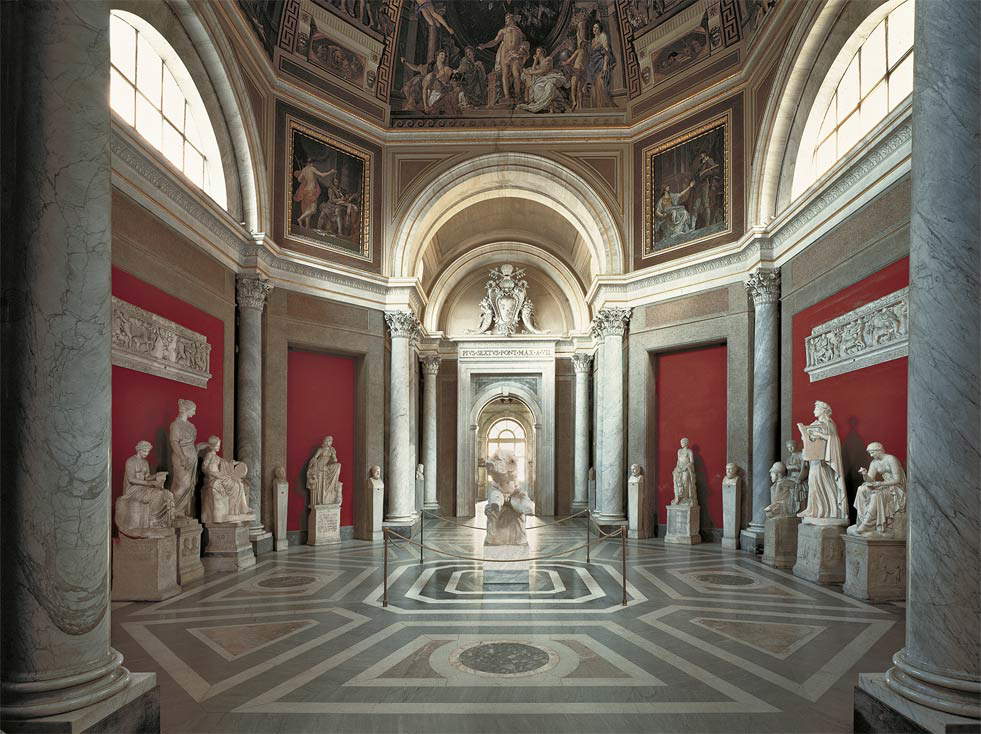
Commissioned by Pope Gregory XVI and inaugurated in the 1830s, the two Gregorian museums, the Egyptian and the Etruscan, are two gems for the quantity and quality of artifacts they house. The Gregorian Egyptian Museum has nine rooms and its collection mainly investigates the relationship between Rome, its empire, and ancient Egypt. There are also numerous Egyptian works of Roman manufacture, testifying to how these ancient cultures merged and came together, as is the case with artifacts from the splendid setting that was Hadrian’s villa in Tivoli. The Gregorian Etruscan Museum, on the other hand, was one of the first expressly dedicated to Etruscan antiquities and bringing together numerous artifacts collected in some of the most important cities of ancient Etruria, then included in the territory of the Papal States. All of these works document the high degree of specialization of Etruscan craftsmanship and the finesse of its art, but they are also an important tool for tracing the long history of this people from the Iron Age to its gradual and definitive incorporation into the structure of the Roman state.
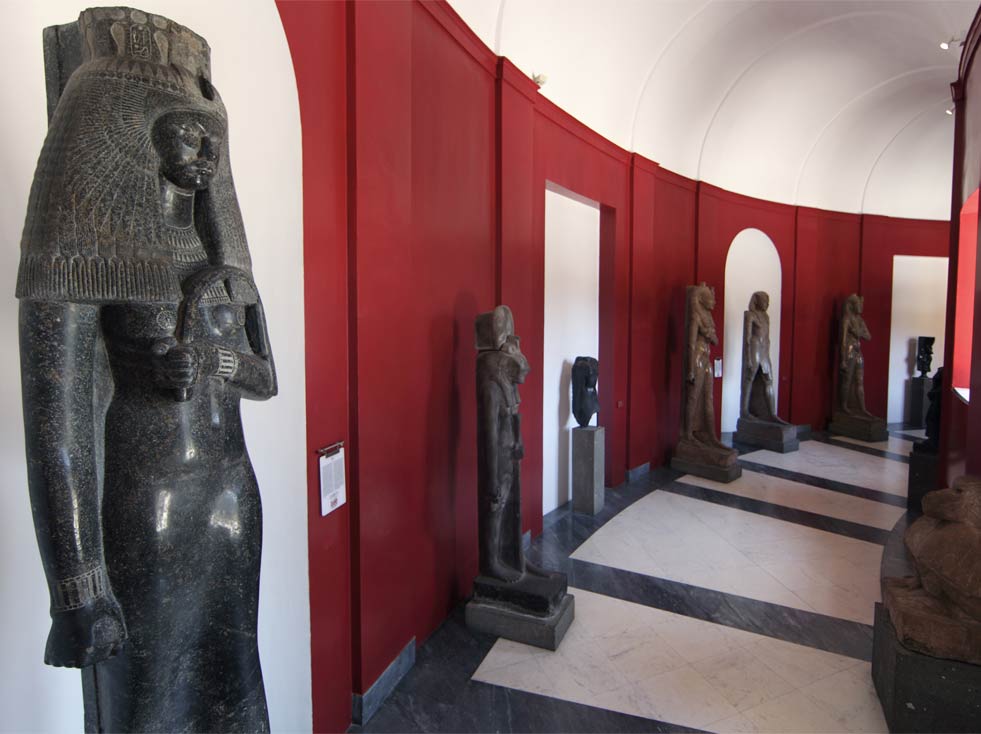
The Pius Christian Museum collects important evidence of the Christian communities of the early centuries. A fundamental contribution to the development and setting up of the Pio Cristiano Museum was made by the Pontifical Commission of Sacred Archaeology, which since the mid-nineteenth century has had the task of bringing to light and collecting the many artifacts, especially sculptural and epigraphic, that were being unearthed from the Roman catacombs, but not only. Today the Pius Christian Museum consists of two major sections: the most important is certainly the one that includes the architectural, sculptural, and mosaic monuments and is especially notable for the splendid collection of sarcophagi. No less fascinating is then the section that collects epigraphic material, subdivided by age and subject. It is, however, a section with a high specialized and documentary content for this reason it is open only to scholars of this particular historical period who can access it upon request.
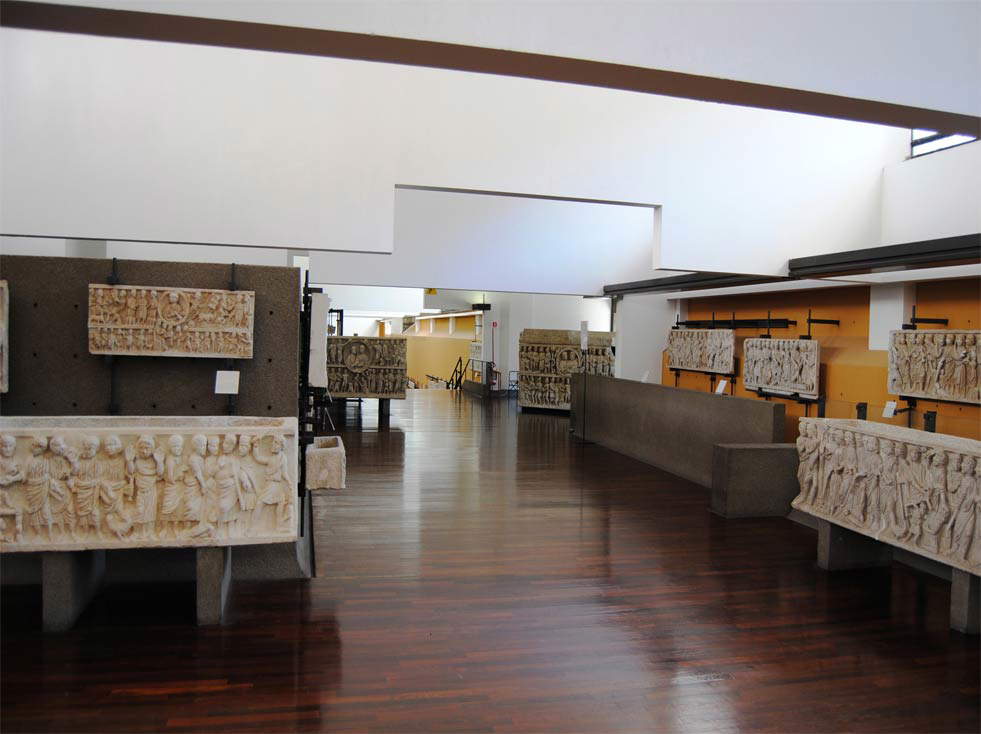
The Chiaramonti Museum bears well imprinted in its organization and collection the hand of one of the greats of world sculpture, Antonio Canova. The Chiaramonti Museum is located in the loggia that connected the Palazzetto di Belvedere with the entirety of the Vatican Palaces and owes its name to Pope Pius VII Chiaramonti, but it is above all a mute witness to an important turning point for Vatican collections, a turning point that goes hand in hand with the fortunes of the Pio Clementino Museum. The collection of classical sculptures housed in the latter museum passed to Napoleon’s France in 1797 with the Treaty of Tolentino, and only after the Congress of Vienna did the most important works return to Rome. In the meantime, however, thanks to a vast campaign of purchases, the new museum was realized starting in 1806. The criteria of the arrangement were dictated precisely by Canova, who aimed to present together the ’three sister arts’: sculpture, in the ancient works on display; architecture, in the corbels obtained from ancient architectural frames; and painting, in the frescoes. The latter were created by young artists of the time at the expense of Canova himself.
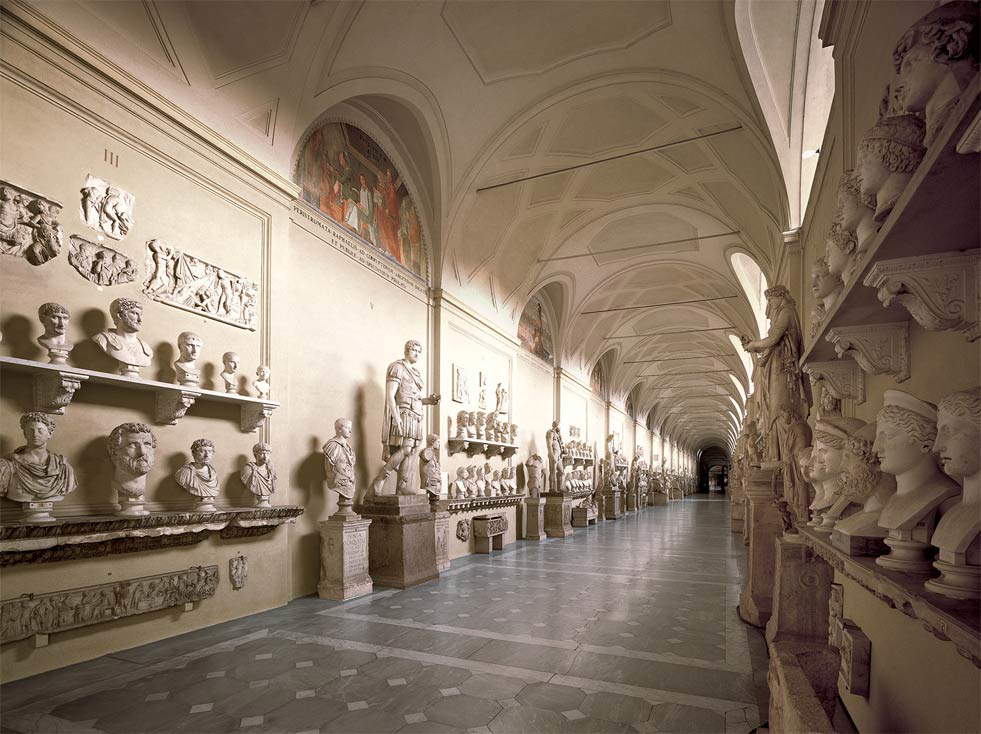
For centuries the center of the church world, the Vatican Palaces are an ancient complex that not only houses important masterpieces inside, but by their austere beauty are themselves. Their origins date back to the mid-9th century when a citadel fortified by the walls ordered by Leo IV, the so-called ’Leonine city,’ stood around the ancient Basilica of St. Peter. By contrast, the nucleus of the present Vatican palaces dates back to the late 13th and early 16th centuries when a number of buildings were built around the square courtyard known as the Pappagallo. The most important expansion came only with the 15th century, however, when the Palazzi di Sisto were built, including the Sistine Chapel named after this pope, and those of Innocent VIII, which are located 300 meters north of the Vatican basilica. We owe to Julius II and his architect Donato Bramante, however, the idea of connecting the two cores of palaces built by his predecessors by means of two longitudinal bodies that enclosed a grandiose courtyard divided into three levels. The popes of the sixteenth and seventeenth centuries continued and expanded the Vatican Palaces. In particular, it was Sixtus V who initiated the construction of the building in which the pope currently resides and from which he looks out every Sunday at noon to bless the crowds that gather in St. Peter’s Square.
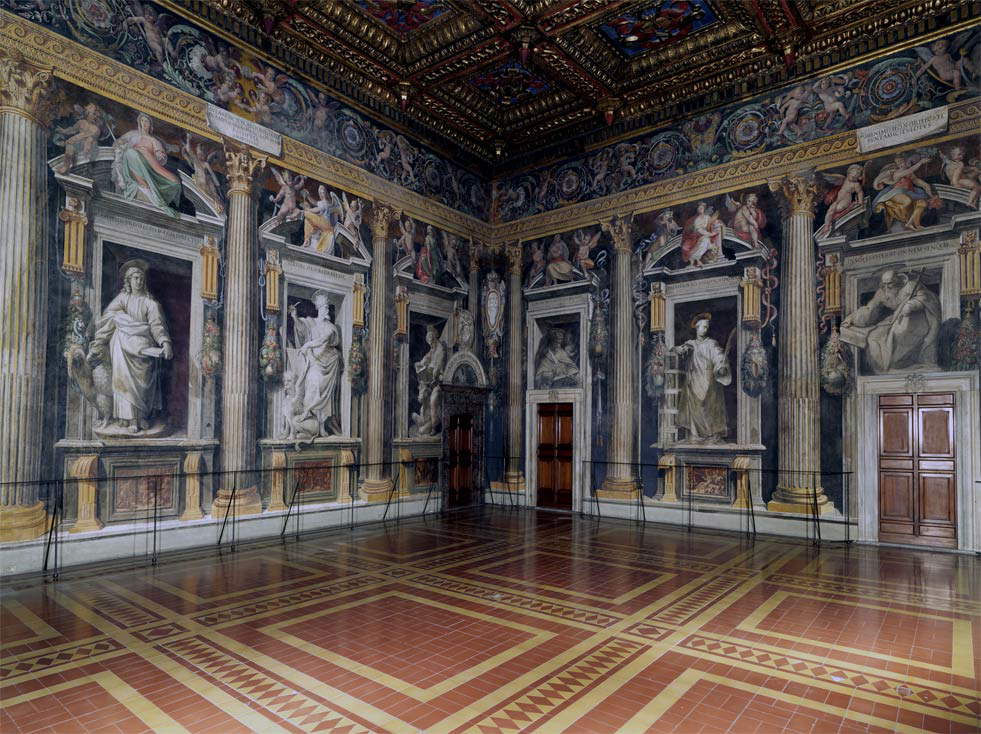
TheBorgia Apartment was the residence of Pope Alexander VI, the Spaniard Rodrigo de Borja y Doms, during whose pontificate, which lasted from 1492 to 1503, America was discovered and the Great Jubilee of 1500 was celebrated. The Borgia Apartment includes six rooms that now house part of the Contemporary Art Collection of the Vatican Museums, but are themselves works of art. Of particular interest is the pictorial decoration of the rooms reserved for the pontiff, which was taken care of by the painter Bernardino di Betto, better known by his nickname Pinturicchio, one of the greatest exponents of the Umbrian school at the close of the 15th century. According to many, the decoration of the Borgia Apartment constitutes the pinnacle of Pinturicchio’s brilliant career, to whom Alexander VI himself also entrusted a vast cycle of frescoes in Castel Sant’Angelo now lost. Embellishing even more what was done in the Appartamento Borgia, however, is not only the hand of the person who decorated it, but also the technique used. The painter resorted only partially to fresco, alternating it with a particular mixed-painting technique revealed by recent restorations, which is faster and more similar to dry painting on panel.

 |
| Vatican Museums, what to see: the museums of the popes in 10 steps |
Warning: the translation into English of the original Italian article was created using automatic tools. We undertake to review all articles, but we do not guarantee the total absence of inaccuracies in the translation due to the program. You can find the original by clicking on the ITA button. If you find any mistake,please contact us.